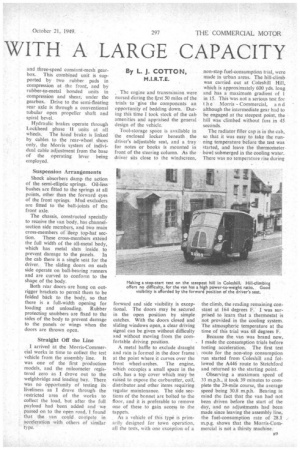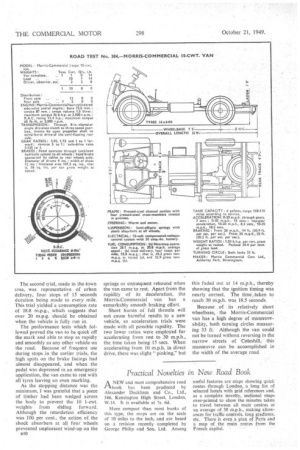A SMALL VAN WITH A LARGE CAPACITY
Page 42

Page 43

Page 44

If you've noticed an error in this article please click here to report it so we can fix it.
Specially Designed for Local Deliveries, the Morris-Commercial Occupies Little Road Space, has Large Carrying Capacity, is Highly Manceuvrable and is Convenient for the Driver
By L. J. COTTON,
M.I.R.T.E.
"MOM PARED with an average c"N
modern 10-cwt. delivery van,
the Morris-Commercial vehicle of this class has 30 cubic ft. more earning capacity, yet its overall length is at least 8i ins. shorter. It has been designed from the start as a commercial vehicle with full forward control, instead of being evolved from a private car.
Although the power unit may not be so accessible for maintenance as that of a contemporary normalcontrol model, the positions of the controls and the sliding doors of the cab provide easier aces to the driving seat. This is a detail which will be appreciated on local-delivery work, for which the light van is normally employed.
The Mekrris-Commercial 10-cwt. van, which was announced and exhibited for the first time at last year's Commercial Motor Show, is equipped with a four-cylindered side-valve petrol engine, which affords a lively performance for its litre capacity. Although the engine has a relatively "square" bore B8 and stroke of 73.5 mm. and 87 min. respectively, it is not a high-speed unit. A power output of 36 b.h.p. is available at 3,500 r.p.m., and 65 lb.-ft. torque at 2,000 r.p.m.
The engine specification includes a three-bearing crankshaft, whitemetal-lined detachable shells for the main and big-end bearings, aluminium pistons and a gear-driven camshaft. The cylinder block is cast integrally with the crankcase. Fuel is fed to the Solex carburetter by a 12-volt electric pump, and the distributor, with automatic advance and retard mechanism, is driven in tandem with the oil pump.
The power unit is mounted in the frame in conjunction with the clutch and three-speed constant-mesh gearbox. This combined unit is supported by two rubber pads in compression at the front, and by rubber-to-metal bonded units in compression and shear, under the gearbox. Drive to the semi-floating rear axle is through a conventional tubular open propeller shaft and spiral bevel.
Hydraulic brakes operate through Lockheed phase II units at all wheels. The hand brake is linked by cables to the rear-wheel shoes only, the Morris system of individual cable adjustment from the base of the operating lever being employed.
Suspension Arrangements Shock absorbers damp the action of the semi-elliptic springs. Oil-less bushes are fitted to the springs at all points, other than the forward eyes of the front springs. Mud excluders are fitted to the ball-joints of the front axle.
The chassis, constructed specially to receive the van body, has channelsection side members, and two main cross-members of deep top-hat section. These cross-members extend the full width of the all-metal body, which has metal slats inside to prevent damage to the panels. In the cab there is a single seat for the driver. The sliding doors on each side operate on ball-bearing runners and are curved to conform to the shape of the body.
Both rear doors-are hung on outrigger brackets to permit them to be folded back to the body, so that there is a full-width opening for loading and unloading. Rubber protecting snubbers are fixed to the sides of the body to prevent damage to the panels or wings when the doors are thrown open.
Straight Off the Line I arrived at the Morris-Commercial works in time to collect the test vehicle from the assembly line. It was one of the first production models, and the mileometer registered zero as I drove out to the weighbridge and loading bay. There was no opportunity of testing its liveliness as I drove through the restricted area of the works to collect the load, but after the full payload had been added and we passed on to the open road, I found that the van could compete in acceleration with others of similar type. „. The engine and transmission were nursed during the first 50 miles of the trials to give the components an opportunity of bedding down. During this time I took stock of the cab amenities and appraised the general design of the vehicle.
Tool-storage space is available in the enclosed locker beneath the driver's adjustable seat, and a tray for notes or books is mounted in front of the steering column. As the driver sits close to the windscreen, forward and side visibility is exceptional. The doors may be secured in the open position by simple catches. With the doors closed and sliding windows open, a clear driving signal can be given without difficulty and without moving from the comfortable driving position.
A metal baffle to exclude draught and rain is formed in the door frame at the point where it curves over the front wheel-arches. The engine, which occupies a small apace in the cab, has a top cover which may be raised to expose the carburetter, coil, distributor and other items requiring regular maintenance. The side sections of the bonnet are bolted to the floor, and it is preferable to remove one of these to gain access to the tappets.
As a vehicle of this type is primarily designed for town operation, all the tests, with one exception of a non-stop fuel-consumption trial, were made in urban areas. The hill-climb was carried out at Coleshill Hill, which is approximately 600 yds. long and has a maximum gradient of 1 in 15. This Was not a serious test for t h e Morris Commercial, a n d although the intermediate gear had to be engaged at the steepest point, the hill was climbed without fuss in 45 seconds.
The radiator filler cap is in the cab, so that it was easy to take the running temperature before the test was started, and leave the thermometer. bowl submerged in the cooling water. There was no temperature rise during the climb, the reading remaining constant at 164 degrees F. I was surprised to learn that a thermostat is not provided in the cooling system. The atmospheric temperature at the time of this trial was 68 degrees F.
Because the van was brand new, I made the consumption trials before testing acceleration. The first test route for the non-stop consumption run started from Coleshill and followed the A446 route to Stetchford and returned to the starting point.
Observing a maximum speed of 33 m.p.h., it took 39 minutes to complete the 29-mile course, the average speed being 30.8 mph. Bearing in mind the fact that the van had not been driven before the start of the day, and no adjustments had been made since leaving the assembly line, the fuel-consumption rate of 28.1 m.p.g. shows that the Morris-Commercial is not a thirsty machine. The second trial, made in the town area, was representative of urban delivery, four stops of 15 seconds duration being made to every mile. This trial yielded a consumption rate of 1S.,8 m.p.g., which suggests that over 20 m.p.g. should be obtained when the vehicle is fully run in.
The performance tests which followed proved the van to be quick off the mark and able to stop as rapidly and smoothly as any other vehicle on the road. Because of frequent use during stops in the earlier trials, the high spots on the brake facings had almost disappeared, and when the pedal was depressed in an emergency application, the van came to rest with all tyres leaving an even marking.
As the stopping distance was the minimum, I was grateful that a piece of timber had been wedged across the body to prevent the 10 1-cwt. weights from sliding forward. Although the retardation efficiency was 100 per cent, the action of the shock absorbers at all four wheels prevented unpleasant wind-up on the springs or consecpsent rebound when the van came to rest. Apart from the rapidity of its deceleration, the Morris-Commercial van has a remarkably smooth braking effort.
Short bursts of full throttle will not cause harmful results to a new vehicle, so acceleration trials were made with all possible rapidity. The two lower ratios were employed for accelerating from rest to 30 m.p.h., the time taken being 15 sees. When accelerating from 10 m.p.h. in direct drive, there was slight "pinking," but this faded out at 14 m.p.h., thereby showing that the ignition timing was nearly correct. The time .taken to reach 30 m.p.h. was 18.5 seconds.
Because of its relatively short wheelbase, the Morris-Commercial van has a high degree of manceuvrability, both turning circles measuring 33 ft. Although the van could not be turned without reversing in the narrow streets of Coleshill, this manceuvre can be accomplished in the width of the average road.




























































































